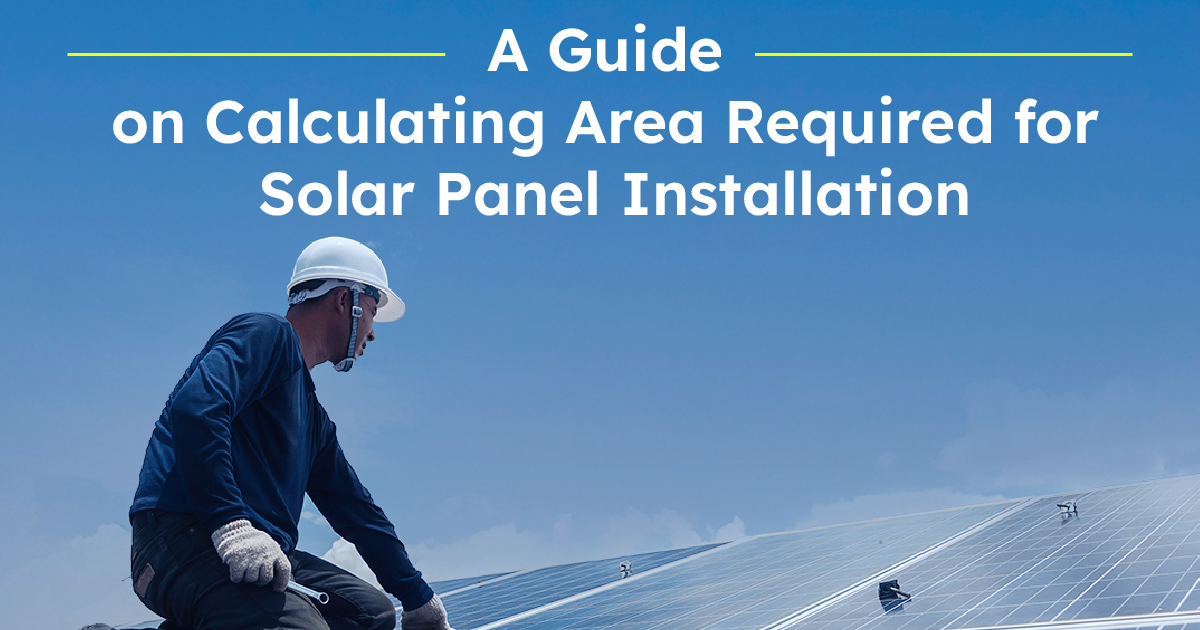The constantly increasing global warming and rising costs of electricity bills are resulting in the huge adoption of renewable and affordable solar energy. This alternative source of energy proves completely environment-friendly as no harmful greenhouses are emitted during power generation and consumption. Thus, there are no health and environmental hazards. Moreover, different types of financial assistance are provided by the government for solar panel installers to help them with cost savings.
When planning a solar panel purchase and installation, the major concern is deciding –
- How many solar panels do I require for my power consumption needs to ensure effective renewable sunny investment?
- How much space do I need to reserve on my rooftop or the ground for the panel installation?
The installation area of the solar panel is also based on whether you need rooftop solar panel installation or on the ground. The installation space of a single piece of a panel on the rooftop is nearly 2.1-2.2m2 and 2.5m2 for solar panels on the ground. To calculate the total area, multiply the total number of solar panels x 2.1 m2 or 2.2 m2 for the rooftop and 2.5 m2 for panels on the ground.
First, determine the total number of solar panels you need
Determining how many solar panels you need to purchase and install is much easier. All you have to do is access all electricity bills for the previous 12 months. On the bill, you will see a column featuring the electricity units in kWh (kilowatt-hour) consumed every month. The solar panel size depends on the cell configuration and panel wattage. 350 W solar panel will be larger than a 100 W solar panel as it has multiple solar cells.
Find monthly unit consumption by adding them and dividing the total figure by 12.
Now, divide the average monthly electricity consumption (in units) by the total units produced by a 1-kilowatt solar panel each month. This provides the total size of your solar system in kilowatts or kW.
According to the thumb rule, a 1 kW solar system in India can produce around 4 units of power a day. So, in a month, a 1 kW solar system can produce 120 units (4 units per day x 30 days of a month).
At last, divide the total size of solar panels by the total size of a single solar panel to get the total number of solar panels you will need for your home.
Now it’s time to calculate the area required by solar panels
Once you have estimated the number and size of solar panels you need, you have to determine the area required on your rooftop, backyard, or garden to install solar systems and enjoy cost saving through solar power while ensuring complete environmental safety.
To better understand how to get a rough estimate of the surface area essential for solar panel installation, let us take an example. You need the installation of ten solar panels having approximately 18% conversion efficiency and 100 Watts ratings of each.
Compute the total energy output of the solar panel using the following formula:
Total surface area x solar irradiance x conversion efficiency = total power output
The total power output is 1000 W or watts (10 panels x 100 watts), solar irradiance is 1000W/m2,and the conversion efficiency is 18%.
Putting these figures in the above-mentioned formula, we will get –
1000 = total area x 1000 x 0.18
Total area = 1000/180 = 5.56m2
For installing all the solar panels in one row, approximately 1m x 5.56m of space is essential as each solar panel is 1m x 0.556m in size.
The results of the calculation of your solar panels may change because panels are installed at an angle to the surface of the earth. This is the way to calculate the area required to install solar panels side by side and back to back to each other.
Alongside solar panels, some more solar technologies come with panels including a solar battery, inverter, and controller. These systems are recommended to be placed in a dry and ventilated room (close to the solar panel to reduce the loss of line). Also, while installing the panels, some space is left between rows and columns for easier maintenance and cleaning.
What is the standard size of a quality solar panel?
The standard size of –
- A 250 W solar panel having a 60-cell configuration is 3.25 ft. X 5.5 ft.
- A 330 W solar panel having 72 cell configuration is 3.25 ft. X 6.42 ft.
The thickness of solar panels of 6 and 72 cell configuration is approximately 40mm. The size and weight of solar panels differ based on the manufacturing company.
How much area is required to install ground-mounted solar panels?
Compared to rooftop solar systems, ground-mounted solar panels require more space for installation. Each solar panel requires approximately 18 sq. ft. space. Thus, for installing 20 solar panels on the ground, you will require 360 square feet of shade-free area.
Conclusion
At the bottom line, according to the thumb rule of the solar industry, 1 kW of solar panel can be installed in a 100 square feet area having no shaded space on the roof. However, 1 kW of solar panels can be installed in a shadow-free space of 85 square feet on a metal shed. Most advanced solar panels used for industrial, residential, and commercial applications have more than 300-watt peak power ratings.
To determine the accurate area and size and number of solar panels, get in touch with Megamax Solar. They are the best rooftop solar system installers in Delhi NCR specializing in providing an extensive range of solar systems and solutions. The installers provide best-in-class installation after doing a complete site inspection and analysis of your power consumption needs. So, if you want to go solar for your home, office, or residential societies, contact the experts for hassle-free and affordable installation of the most suitable solar system plus after-sales service.

